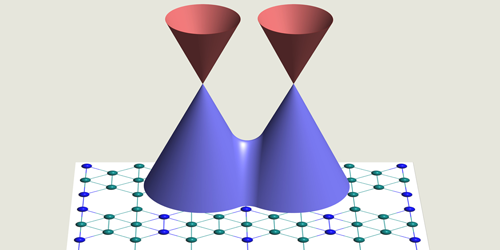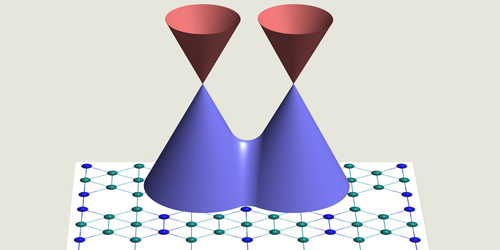Dirac Cones in Boron’s Version of Graphene
Single-layer carbon, or graphene, has highly desirable properties that are the envy of other materials. But a new study of single-layer boron, or borophene, shows that it boasts at least one graphene-like property: Dirac cones in the electronic band structure. These cones are associated with high charge mobility and an anomalous quantum Hall effect. The discovery of Dirac cones in borophene suggests that the range of crystal structures with graphene-like properties is wider than previously thought.
Graphene’s two-dimensional honeycomb lattice has symmetry properties that lead to gapless points where the conduction and valence bands meet. The bands around these points have a cone shape, which induces electronic excitations—called Dirac fermions—that behave as if they were massless. Besides graphene, researchers have found evidence for Dirac cones and fermions in other materials (like single-layer silicon) that also have a honeycomb crystal structure.
Borophene, which was first realized in a lab in 2015, has a crystal structure that is not exactly a honeycomb. When grown on a silver substrate, boron atoms assemble in a hexagonal pattern with additional atoms sitting in the centers of some of the hexagons. Iwao Matsuda, from the University of Tokyo, and colleagues investigated a specific type of borophene (called ). They first calculated the band structure, uncovering evidence for Dirac cones. To confirm this prediction, the team performed photoemission spectroscopy. They found that each borophene cone is actually split into a pair of cones because of the influence of the silver substrate. The results could open the door to materials with novel properties, as the large unit cells in borophene’s lattice make the material conducive to atomic-scale engineering.
This research is published in Physical Review Letters.
–Michael Schirber
Michael Schirber is a Corresponding Editor for Physics based in Lyon, France.





